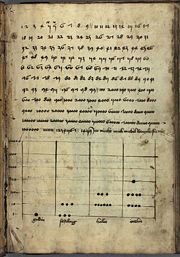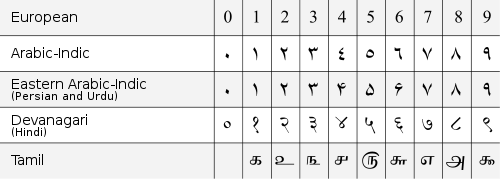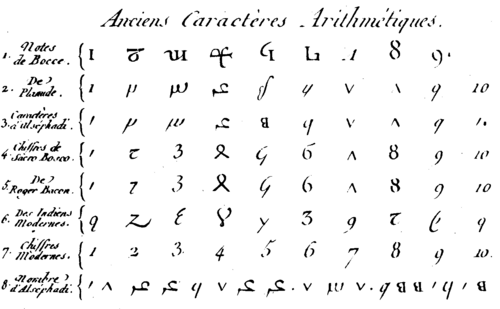Arabic numerals
| Numeral systems by culture | |
|---|---|
| Hindu-Arabic numerals | |
| Western Arabic Eastern Arabic Khmer |
Indian family Brahmi Thai |
| East Asian numerals | |
| Chinese Suzhou Counting rods |
Japanese Korean Mongolian |
| Alphabetic numerals | |
| Abjad Armenian Cyrillic Ge'ez |
Hebrew Greek (Ionian) Āryabhaṭa |
| Other systems | |
| Attic Babylonian Egyptian English |
Etruscan Mayan Roman Urnfield |
| List of numeral system topics | |
| Positional systems by base | |
| Decimal (10) | |
| 2, 4, 8, 16, 32, 64 | |
| 1, 3, 9, 12, 20, 24, 30, 36, 60, more… | |
The arabic numerals (often capitalized) are the ten digits (0, 1, 2, 3, 4, 5, 6, 7, 8, 9), which—along with the system by which a sequence (e.g. "406") was read as a number—were originally defined by Indian mathematicians, later modified and transferred to North African Arab mathematicians and transmitted to Europe in the Middle Ages, whence they spread around the world through European colonialism. Today they are the most common symbolic representation of numbers in the world.
The term Arabic numerals may refer to the closely related Eastern Arabic numerals (٠.١.٢.٣.٤.٥.٦.٧.٨.٩) which are, to Westerners today, more closely associated with Arabic speakers than the Western Arabic numerals.
Finally, arabic numerals is the conventional name for the family of numerals, invented by Indian mathematicians in around AD 500, which are related to or ancestral to the Western numerals.[1][2] This invention, which involved zero and a decimal positional notation, is considered an important milestone in the development of mathematics.
One may distinguish between the positional decimal system involved in interpreting the numerals, known as the Hindu-Arabic numeral system, which is identical throughout the family, and the precise characters used to write these numerals, which vary regionally. The characters most commonly used in conjunction with the Latin alphabet since Early Modern times are 0 1 2 3 4 5 6 7 8 9.
The reason that (0,1,2,3,4,5,6,7,8,9) are known as arabic numerals is that they are the characters used by western Arabs from Morocco to Libya, from where they were introduced to Europe in the tenth century. The Arabs themselves call them "Hindu numerals", but this term is not restricted to the characters (0,1,2,3,4,5,6,7,8,9), but also includes (٠.١.٢.٣.٤.٥.٦.٧.٨.٩) as well.[1]
Although the phrase "arabic numeral" is frequently capitalized, it is sometimes written in lower case, for instance in its entry in the Oxford English dictionary.[3] This helps distinguish it from the East Arabic numerals specific to the Arabs.
Contents |
History
Origins
The symbols for 1 to 9 in the Hindu-Arabic numeral system evolved from the Brahmi numerals. Buddhist inscriptions from around 300 BC use the symbols which became 1, 4 and 6. One century later, their use of the symbols which became 2, 7 and 9 was recorded.
The first universally accepted inscription containing the use of the 0 glyph is first recorded in the 9th century, in an inscription at Gwalior in Central India dated to 870. However, by this time, the use of the glyph had already reached Persia, and is mentioned in Al-Khwarizmi's descriptions of Indian numerals. Indian documents on copper plates, with the same symbol for zero in them, dated back as far as the 6th century AD, abound.[4]


The numeral system came to be known to both the Persian mathematician Al-Khwarizmi, whose book On the Calculation with Hindu Numerals written about 825 in Arabic, and the Arab mathematician Al-Kindi, who wrote four volumes, "On the Use of the Indian Numerals" (Ketab fi Isti'mal al-'Adad al-Hindi) about 830, are principally responsible for the diffusion of the Indian system of numeration in the Middle East and the West.[5] In the 10th century, Middle-Eastern mathematicians extended the decimal numeral system to include fractions, as recorded in a treatise by Syrian mathematician Abu'l-Hasan al-Uqlidisi in 952–53.
In the Arab world—until modern times—the arabic numeral system was used only by mathematicians. Muslim scientists used the Babylonian numeral system, and merchants used the Abjad numerals. It was not until Fibonacci that the arabic numeral system was used by a large population outside India.
A distinctive West Arabic variant of the symbols begins to emerge around the 10th century in the Maghreb and Al-Andalus, called ghubar ("sand-table" or "dust-table") numerals, which is the direct ancestor to the modern Western Arabic numerals used throughout the world.[6]
The first mentions of the numerals in the West are found in the Codex Vigilanus of 976.[7] From the 980s, Gerbert of Aurillac (later, Pope Silvester II) began to spread knowledge of the numerals in Europe. Gerbert studied in Barcelona in his youth, and he is known to have requested mathematical treatises concerning the astrolabe from Lupitus of Barcelona after he had returned to France.
Adoption in Europe



In 825 Al-Khwārizmī, the Persian scientist, wrote a treatise in Arabic, On the Calculation with Hindu Numerals, which was translated into Latin from Arabic in the 12th century as Algoritmi de numero Indorum, where Algoritmi, the translator's rendition of the author's name, gave rise to the word algorithm (Latin algorithmus, "calculation method").
Fibonacci, a mathematician born in the Republic of Pisa who had studied in Bejaia (Bougie), Algeria, promoted the Arabic numeral system in Europe with his book Liber Abaci, which was written in 1202, still describing the numerals as Indian rather than Arabic.
- "When my father, who had been appointed by his country as public notary in the customs at Bugia acting for the Pisan merchants going there, was in charge, he summoned me to him while I was still a child, and having an eye to usefulness and future convenience, desired me to stay there and receive instruction in the school of accounting. There, when I had been introduced to the art of the Indians' nine symbols through remarkable teaching, knowledge of the art very soon pleased me above all else and I came to understand it.."
The numerals are arranged with their lowest value digit to the right, with higher value positions added to the left. This arrangement was adopted identically into the numerals as used in Europe. The Latin alphabet runs from left to right, unlike the Arabic alphabet. Hence, numerals in western texts have an inverse arrangement of their glyphs relative to the direction of writing.
The European acceptance of the numerals was accelerated by the invention of the printing press, and they became commonly known during the 15th century. Early uses in Britain include a 1445 inscription on the tower of Heathfield Church, Sussex, a 1448 inscription on a wooden lych-gate of Bray Church, Berkshire, and a 1487 inscription on the belfry door at Piddletrenthide church, Dorset and in Scotland a 1470 inscription on the tomb of the first Earl of Huntly in Elgin, (Elgin, Moray) Cathedral. (See G.F. Hill, The Development of Arabic Numerals in Europe for more examples.) By the mid-16th century, they were in common use in most of Europe.[8] Roman numerals remained in use mostly for the notation of Anno Domini years, and for numbers on clockfaces. Sometimes, Roman numerals are still used for enumeration of lists (as an alternative to alphabetical enumeration), and numbering pages in prefatory material in books.
Evolution of symbols
The numeral system employed, known as algorism, is positional decimal notation. Various symbol sets are used to represent numbers in the Hindu-Arabic numeral system, all of which evolved from the Brahmi numerals. The symbols used to represent the system have split into various typographical variants since the Middle Ages:
- The widespread Western Arabic numerals used with the Latin alphabet, in the table below labelled European, descended from the West Arabic numerals developed in al-Andalus and the Maghreb. (There are two typographic styles for rendering European numerals, known as lining figures and text figures).
- The Arabic-Indic or Eastern Arabic numerals used with the Arabic alphabet developed primarily in what is now Iraq. A variant of the Eastern Arabic numerals used in the Persian and Urdu languages is shown as East Arabic-Indic.
- The Devanagari numerals used with Devanagari and related variants are grouped as Indian numerals.

The evolution of the numerals in early Europe is shown on a table created by the French scholar J.E. Montucla in his Histoire de la Mathematique, which was published in 1757:

The arabic numerals are encoded in ASCII (and Unicode) at positions 48 to 57:
| Binary | Dec | Hex | Glyph |
|---|---|---|---|
| 0011 0000 | 48 | 30 | 0 |
| 0011 0001 | 49 | 31 | 1 |
| 0011 0010 | 50 | 32 | 2 |
| 0011 0011 | 51 | 33 | 3 |
| 0011 0100 | 52 | 34 | 4 |
| 0011 0101 | 53 | 35 | 5 |
| 0011 0110 | 54 | 36 | 6 |
| 0011 0111 | 55 | 37 | 7 |
| 0011 1000 | 56 | 38 | 8 |
| 0011 1001 | 57 | 39 | 9 |
See also
- Hindu-Arabic numeral system
- Numeral system
- Counting rods - decimal positional numeral system with zero
- Chinese numerals
- Japanese numerals
- Roman numerals
Notes
- ↑ 1.0 1.1 Ifrah, Georges. 1999. The Universal History of Numbers : From Prehistory to the Invention of the Computer, Wiley. ISBN 0-471-37568-3.
- ↑ O'Connor, J.J. and E.F. Robertson. 2000. 'Indian Numerals', MacTutor History of Mathematics Archive, School of Mathematics and Statistics, University of St. Andrews, Scotland.
- ↑ "Arabic", Oxford English dictionary, 2nd edition
- ↑ Kaplan, Robert. (2000). The Nothing That Is: A Natural History of Zero. Oxford: Oxford University Press.
- ↑ The MacTutor History of Mathematics archive
- ↑ Gandz, Solomon (November 1931), "The Origin of the Ghubār Numerals, or the Arabian Abacus and the Articuli", Isis 16 (2): 393-424
- ↑ Mathorigins.com
- ↑ Mathforum.org
References
- Burnett, Charles (2006), "The Semantics of Indian Numerals in Arabic, Greek and Latin", Journal of Indian Philosophy, (Springer-Netherlands) 34 (1-2): 15-30, doi:.
- Encyclopaedia Britannica (Kim Plofker) (2007), "mathematics, South Asian", Encyclopædia Britannica Online: 1-12, http://www.britannica.com/eb/article-9389286, retrieved on May 18, 2007.
- Hayashi, Takao (1995), The Bakhshali Manuscript, An ancient Indian mathematical treatise, Groningen: Egbert Forsten, ISBN 906980087X.
- Ifrah, Georges (2000), A Universal History of Numbers: From Prehistory to Computers, New York: Wiley, ISBN 0471393401, http://www.amazon.com/Universal-History-Numbers-Prehistory-Invention/dp/0471393401/.
- Katz, Victor J. (ed.) (July 20 2007), The Mathematics of Egypt, Mesopotamia, China, India, and Islam: A Sourcebook, Princeton, NJ: Princeton University Press,, ISBN 0691114854.
External links
- History of Counting Systems and Numerals. Retrieved 11 December 2005.
- The Evolution of Numbers. 16 April 2005.
- O'Connor, J. J. and Robertson, E. F. Indian numerals. November 2000.
- History of the Numerals